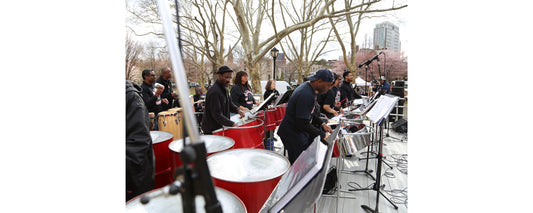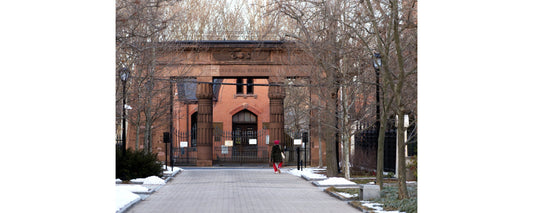One in five women will miss work or school because she doesn’t have access to tampons and pads when she needs them. One in four women struggles to afford period products. The average woman spends $14 a month on them—and more if she can only afford to buy smaller but ultimately more expensive packages. Until 2018, these products were taxed in Connecticut, and they continue to be taxed in 30 other states, because unlike similarly imperative adult incontinence pads, they aren’t universally recognized as health care necessities.
These are some of the facts Quinnipiac students Dorothy Watters and Bobbi Dynice rattle off in a conversation about “period poverty”—a lack of access to needed supplies and sanitary systems for disposing of them. The students are spearheading a period products drive for The Diaper Bank of Connecticut, an organization they first learned about in a class on diaper need taught by psychology professors Clorinda Velez and Anne Eisbach. They have supported the Diaper Bank with two previous drives for diapers and period products.
The two types of products have obvious connections. Janet Alfano, the Diaper Bank’s executive director, sees them as part of a lifetime continuum that also includes incontinence products for children and adults. They’re linked not just by the function they serve but also by the needs of women, “who are caregivers at both the beginning and end of the lifespan and anywhere in-between,” Alfano says.
sponsored by
Since its founding in 2004, the Diaper Bank has quietly received and distributed donations of period products, even though that wasn’t part of its original mission. Spurred on by a new generation of activists like Watters and Dynice, the organization recently decided to make it official. Playing on its sunbeam logo, the Diaper Bank now pursues three related initiatives: Rise for senior incontinence products, Shine for youth incontinence products and Beam for period products. Its existing network of about 70 childcare centers, homeless shelters, home visiting programs, food pantries and other community nonprofits makes it easy for the Diaper Bank to take on period products distribution. In addition, Alfano says new relationships are being forged with organizations that help those who need period supplies but aren’t already part of the diaper network, such as women newly released from prison.
Talking about period supplies may make some people squirm. Dynice recounts the discomfort of a male friend when she asked him to help her carry a pile of donations across campus. When naming their most recent drive, Watters says, student organizers considered and then tossed several more euphemistic names and decided to just say it straight: period products drive. It’s important, she says, to say “exactly what this is: We’re raising money for period products because they’re a medical necessity, and I don’t think there should be an embarrassment when we’re talking about them.”
Alfano agrees. “What young folks are teaching us is to not make people more comfortable. That’s not the role,” she says. “The role is just to talk about it some more and some more and some more.” Some of that talk happens at the state capitol. Legislative advocacy has always been part of the Diaper Bank’s three-pronged mission, which also includes education and product distribution. It supported the drive to eliminate the state tax on diapers and period products as well as a more recent push to provide supplies free in Connecticut high schools, which fell by the wayside when the pandemic interrupted the legislative session early in 2020. There is more work to be done in the future, Alfano says: “These are health-related items, so I would love to see them covered by Medicaid.”
In the absence of tampons and pads, women resort to using rags, toilet paper and even adult diapers. The issue extends to many women who aren’t below the poverty line. Watters offers as an example a Quinnipiac freshman who is “trying to afford products on top of also keeping up with schoolwork, trying to afford just the everyday… things that come your way when being a young adult,” with no easy access to a supermarket if she’s caught off guard. In response to that need, the university recently began offering free period products in some women’s bathrooms and at the student health center. “It doesn’t really make sense to have this product that’s such a necessity to be treated like a luxury,” Watters says.
Dynice is now involved in a project called “Humans with Periods”—a take on the popular “Humans of New York” blog but also a nod to the fact that not everyone who menstruates identifies as a woman. Conceived by a high school student from Wilton, the project involves collecting stories about period poverty and stigma. Local high school and college students, including Dynice, are reaching out to various constituencies with a questionnaire. The Diaper Bank will post some of the responses on its social media accounts during Period Poverty Week, from May 24 to 30.
Last year, Alfano says, the Diaper Bank distributed 50,000 period products throughout Connecticut, a small number compared to the more than 2 million diapers distributed. But she expects that number to rise as the organization pivots to thinking about period products as more than “just ancillary to the diapers.” The vast majority of those products were donated by individuals and Kimberly Clark, the manufacturer of U by Kotex products. The Diaper Bank’s bulk purchasing power means it can also buy period products at a reduced cost, as it does with diapers. Quinnipiac students are holding their on-campus drive through May 5, but those outside the campus community can drop off products by appointment on the fourth Friday of every month at the Diaper Bank’s State Street location in North Haven.
Increasing collection and distribution is one goal, but Alfano has her eye on longer-term solutions as well. “We’re adding distribution, but we would hope to do it more efficiently by changing [public] policy,” she says. “It’s incremental, so we take the little, small victories and keep pushing forward.”
Beam, a program of The Diaper Bank of Connecticut
370 State Street, North Haven (map)
(203) 934-7009 | info@thediaperbank.org
www.thediaperbank.org/beam
Written and photographed by Kathy Leonard Czepiel.








